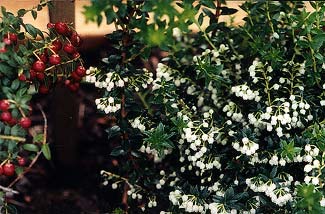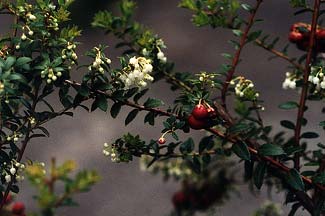 | |
| A Male Pernettya in full bloom in May is the shrub on the right. To his left is a female with many berries lingering from the previous year. The second photo further down on the page shows the same female shrub a week or so later when she had buds & blooms erupting alongside the old berries. There is never a season when this evergreen lacks berries! And they are most tasty after they have wintered & sweetened up. I've eaten them a couple at a time & rather like them, but am leery of harvesting them to make jelly because they persistently end up on lists of poisonous plants, I suspect very wrongly. | |
Are Pernettya Berries Edible or Poisonous?
Because Pernettya mucronata aka Gaultheria mucronataproduces copious quantities of physically gorgeous berries, it has become a popular ornamental shrub, & I've a separate page of praise for Pernettya's Ornamental Value. The Yamanas Indians of Terra del Fuego called P. mucronata "Gush" & counted on the berries as a major food resource in summer & winter. Many other tribal peoples of Central & South America were as reliant on P. prostrata.
But there are other species of pernettya that are apparently poisonous, though good studies & evidence are pretty skimpy; & so one finds all pernettya species broadly condemned as potential hazards, repeatedly included on lists of plants with toxic flowers, stems, & berries.
The North Carolina State University of College of Agricultural & Life Sciences lists Pernettya spp collectively as all "Highly Toxic, May Be Fatal if Eaten," making no distinctions for the species that have long provided wild food harvests for aboriginal peoples, nor attempting to explain how, if they are all so fatal, so many aboriginal peoples eat them without injury. NCSU provides no citation or indication of any study of a purported toxicity universal to Pernettya spp, & truly I suspect Pernettya would be banned from suburban gardens if such a deadly level of toxic response to eating it were possible. Kids are without any doubt sampling these beautiful berries but are not dropping dead left & right. I've never heard of any death resulting from pigging out on the berries of the commonly gardened P. mucronata.
Given its appearance on lists of toxic plants, this will doubtless sound insane to some people, but I decided to try eating the enlarged spring berries. The berries develop in summer & autumn & remain on the branches through winter as small beautiful gems, then in spring they begin to grow larger. I quickly discovered the after-winter berries are rather tasty & not at all seedy, though somewhat bland. Granny Artemis tried one & spat it out as tasteless or crummy, but I like them.
 I've very little doubt that sweetened up a bit, they'd make an excellent jam or jelly, despite the recurring claims that Pernettya can cause symptoms of drunkenness, hallucination, paralysis, & death. I chowed down on raw ones three days running, just a small handful each time lest Granny Artemis have to rush me to the hospital to get my stomach pumped. The berries didn't even get me slightly stoned.
I've very little doubt that sweetened up a bit, they'd make an excellent jam or jelly, despite the recurring claims that Pernettya can cause symptoms of drunkenness, hallucination, paralysis, & death. I chowed down on raw ones three days running, just a small handful each time lest Granny Artemis have to rush me to the hospital to get my stomach pumped. The berries didn't even get me slightly stoned.Lest that leave you with the impression that I'm out gardening for plants that will get me high, no, my only drug is coffee, & that one's troubling enough. But I like having edible berries in my garden. Pernettya being related to so many edible berries (cranberries, blueberries, & most closely related to wintergreen) I suspected the toxic threat was at least exaggerated if not incorrect. Therefore when the Raintree Nursery cataloged P. mucronata under the elsewhere unseen name of "Chilean Wintergreen," promising P. mucronata provides edible berries, I was pretty certain they were not at risk of legal problems for having paralyzed or killed people who took them at their word, or induced LSD-like experiences in unsuspecting clientelle.
An informational article about Pernettya from the New York Botanical Garden notes states: "There are mixed reports, both in the literature & orally, as to the edible nature of the fruits of Pernettya in their natural habitats. These reports range from statements that the fruits are sweet or edible, although somewhat insipid, to claims of intoxication." The NYBG seemed unwilling to say, "Go ahead & eat them," but also gives no warning against it. Alas NYBG didn't distinguish species either, & this failure to draw distinctions likely explains their befuddlement.
"Sweet but somewhat insipid" struck me as the correct description. Perhaps it is true some species of pernettya possess chemical properties which can be hallucinogenic, I don't know; but then, so does cinnamon & many other plants you'd be awfully hard pressed to get a buzz off of. Some berries of the Ericaceae family of plants are indeed toxic, usually only the ones that are also terribly tart, & even most of those lose their toxicity when cooked & are edible sweetened. Such detailed specifics for pernettya I could not find.
Ethnobotanical reports indicate that Indian peoples from Mexico to Chile will injest P. furens & P. parvifolia to get intoxicated. An Indian name for P. furens is "Hierba Loco" the Insanity Herb, & a Peruvian name for P. parvifloilia is Macha-Macha, drunkenness. When references to toxic pernettyas do name the exact species, these are the two pernettyas named, leading to my suspicion that other species should not be so easiy condemned. One authority on pernettyas (cited in the NYBG article) admits that he personally "has eaten quantities of P. mucronata (in Argentina) and P. prostrata (in Venezuela) without side effects."
As yet no scientific study of the chemical components has been undertaken to explain or substantiate the claims of hallucinogenic or deadly components of P. furens & P. parvifolia. But to assume some truth to the uninvestigated possibility of dangerous mind-altering components to these species probably should not be extended to all species of pernettyas. When this broad condemnation is made, it leads to a natural confusion whenever it is discovered that P. prostrata, P. leucocarpa, of & our garden varieties of P. mucronata turn out to be regarded by many peoples as having perfectly edible berries.
The other possibility, that I'm just awfully lucky I'm not dead, doesn't seem nearly as likely to me.
So while the Horticultural Trades Association recommends the warning "Harmful if eaten" be tagged on all pernettyas offered for sale, a contrary opinion is expressed by Plants for a Future (a British resource center for edible plants), & Dr. Rob Fletcher's Australian New Crops Newsletter, which have listed Pernettyas as requiring further investigation as possible new agricultural food crops.
So as you can see, I wasn't really risking paralysis & death by sampling this allegedly toxic berry. I haven't harvested them in large numbers to make jellies because the warnings against them are hard to set aside entirely, even being 99.9% convinced the claims that P. mucronata is toxic are unwarranted. I wish I had definitive information derived from careful research & scientific testing, as it's my belief that these berries are in all likelihood a premium choice for home canning, & the rumor of poisonousness has become an untested oral tradition. After all, tomatoes are a comparatively recent food staple because Victorians & Edwardians were convinced they were deadly, & the superstitious horror of the beneficial hemp plant keeps it banned in the United States as though we're all at risk of becoming hopelessly addicted to smoking ship rope.
So if you decide to make Pernettya Pie for the family, do e-mail me & let me know you're all okay.